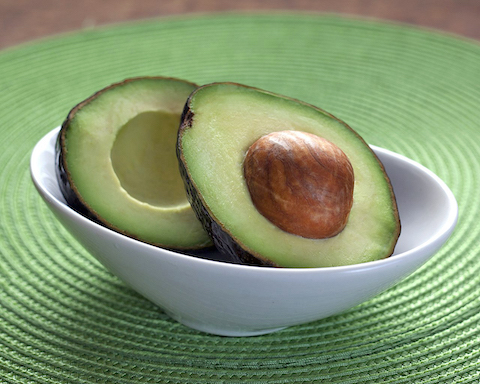
On Super Bowl Sunday, Americans eat 26 million avocados in our guacamole. Annually, we average 8 pounds of avocados per person.
A third of the world’s supply comes from Mexico, which is where the avocado developed.
It began as a small black fruit called the criollo from the same family of trees that produce bay leaves and cinnamon.
The fruit was a favorite of giant herbivores, similar to today’s rhinos and elephants. They would ingest the fruit and poop out the seed, propagating the trees.
When those animals went extinct, the criollo might have too. Except, 10,000 years ago, humans began to propagate it.
Early Mexicans picked the best fruits and grew trees from them. Over generations, this upward selection gradually turned the modest criollo into the large, meaty avocado we know today.
But it wouldn’t grow well in the colder US. until a mailman named Rudolph Hass crossed Mexican and Guatemalan trees in his California orchard to create the breed that bears his name: the Hass avocado.
Eighty percent of avocado trees in the US descend from his one mother tree.
Besides being delicious, avocados decrease your risk of heart disease and lower your bad cholesterol while increasing your levels of good cholesterol. All good reasons to eat one.
When you do, you can thank a prehistoric rhino, the Maya and a California mailman.
Background
Synopsis: If you love avocados, you can thank a postman, the Maya and ancient megaherbivores for bringing them to you over the past few million years. Technically they are berries with their single large seed encased in buttery flesh that is spread on tortillas and toast, rolled into sushi, and blended into superfood smoothies.
- Americans eat more than 2.5 billion pounds of avocados per year—that’s nearly 8 pounds per person per year.
- More than 26 million individual avocados are consumed in about 8 million pounds of guacamole each February for America’s annual Super Bowl Sunday.
- The global market for avocados exceeds $13 billion and is growing.
- Mexico produces more than 32% of the fruit followed by the Dominican Republic, Peru, Indonesia, Colombia, Brazil, Kenya, the United States, Venezuela, Israel and China.
- Avocado is a popular superfood because of its high nutrient value and health benefits as well as its creamy texture and mild taste.
- Sodium- and cholesterol-free avocados provide more than 20 vitamins and minerals as well as protein and healthy monounsaturated fats.
- They provide more potassium than bananas, helping to maintain important electrical gradients in the human body.
- A total of 7% fiber in avocados helps friendly gut bacteria.
- Eating avocados has been shown to decrease risk factors for heart disease, decreasing triglycerides, total and LDL (bad) cholesterol, while increasing LDL (good) cholesterol.
- Avocados are a fruit tree from the laurel family which includes magnolia, bay laurel and cinnamon trees. Laurels have flourished in warm subtropical climates for around 100 million years and were distributed widely on the Gondwana supercontinent.
- The avocado tree (Persea americana) evolved in what is now the Tehuacán Valley of Mexico about 10 million years ago in the Late Miocene Epoch.
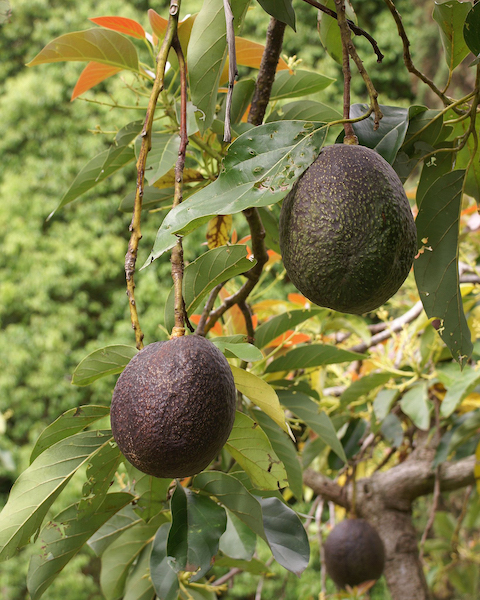
Avocados are sometimes called “alligator pears” because of their bumpy skin. Credit: B.navez, CC BY-SA 3.0 <https://creativecommons.org/licenses/by-sa/3.0>, via Wikimedia Commons - They are cultivated in tropical and Mediterranean type climates with their spherical to pear-shaped fruits weighing from 8 oz (220 g) to 3 lb (1.4 kg) and ranging in color from green to purple and black.
- From a botanical standpoint, the avocado is a large berry differing from drupes (peaches, plums and cherries are all drupes) because they lack a hard seed covering over their single seed.
- Avocados are self-pollinating with their flowers opening as female on the first day and then closing overnight and opening as male on the second day of blooming.
- Growers typically graft the trees onto disease resistant rootstock.
- The most popular variety of avocado today is the Hass Avocado.
- The avocado tree (Persea americana) evolved in what is now the Tehuacán Valley of Mexico about 10 million years ago in the Late Miocene Epoch.
- Except for a few critical evolutionary interventions, the avocado might have become extinct!
- The undomesticated variety of avocado is a small black fruit with a large seed called a criollo that is thought to have coevolved with extinct megaherbivores like giant ground sloths, rhino-like toxodons, and elephant-like gomphotheres.
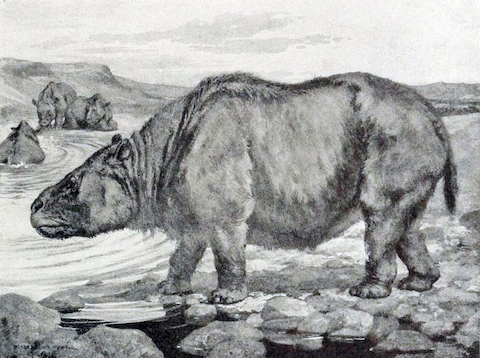
Huge megaherbivores like the toxodon consumed and distributed nutritious avocados around the region of Central America. Credit: 1913 drawing by Robert Bruce Horsfall via Wikimedia Commons - These huge Pleistocene vegetarians needed to consume massive quantities of leaves and grass a day, and the nutrient dense fruit would have helped them meet their caloric needs.
- Once consumed, the seeds would make their way through the digestive tract of these massive animals as they ambled across the terrain, eventually depositing the seeds in large piles of dung, spreading the seeds around the region, along with beneficial fertilizer.
- When the megaherbivores suffered extinction, there were no animals large enough to consume and distribute the seeds, so avocados were also at risk of extinction. But another consumer came along just in time.
- The oldest known avocado pit attributed to human use was found in the Coxcatlan Cave in the Tehuacán Valley of south central Mexico. The 9,000–10,000-year-old seed was found with artifacts from a band of foragers. Nearby caves also showed consumption of avocados.
- Evidence of avocado use from as long ago as 4,500 years comes from Peru as well.
- The Olmecs and Maya cultivated avocado orchards, selecting trees that produced the best tasting and meatiest fruits, and propagated them in the region.
- The Maya had sacred avocado groves and believed that you could be reincarnated as a fruit tree, and if you were important enough, you might be reincarnated as an avocado tree.
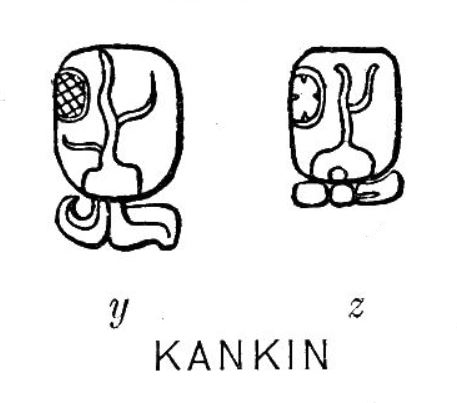
The Maya solar calendar included a month called K'ank'in illustrated by a glyph depicting an avocado tree. Credit: Project Gutenberg 1915 - The Mayan name of the area that is now called Pusilhá in Belize included the glyph for avocado; today, it is known as the Kingdom of the Avocado.
- A water jar shaped like an avocado from the pre-Incan city of Chan-Chan was dated to AD 900.
- Accounts of avocados first appeared in European texts in 1519 and 1526, and the first trees were introduced to Spain in 1601.
- The first use of the word avocado was in a Jamaican botanical text in 1696.
- In 1825, avocados were introduced to the United States mainland. Attempts to cultivate them in the U.S. struggled from the 1830s through 1860s until a cold tolerant variety called the fuerte was identified.
- The fuerte prospered in places like California and became the top selling avocado in America with 75% of the market into the 1940s. Now, the fuerte is a niche market avocado with just 2% of California’s market.
- The creamier and more flavorful Hass (rhymes with pass) avocado displaced the fuerte in popularity after a mail carrier named Rudolph Hass developed a new variety on his tiny California orchard.
- The first American patent awarded for a tree was Rudolph Hass’s 1935 avocado tree patent.
- Most growers ignored the patent, grafting their own trees from fuerte rootstock and Hass cuttings. During his life, Hass made only $5000 on the patent.
- 80% of the avocado trees in the U.S. are descended from this mother tree that grew to 65 feet and lived until 2002.
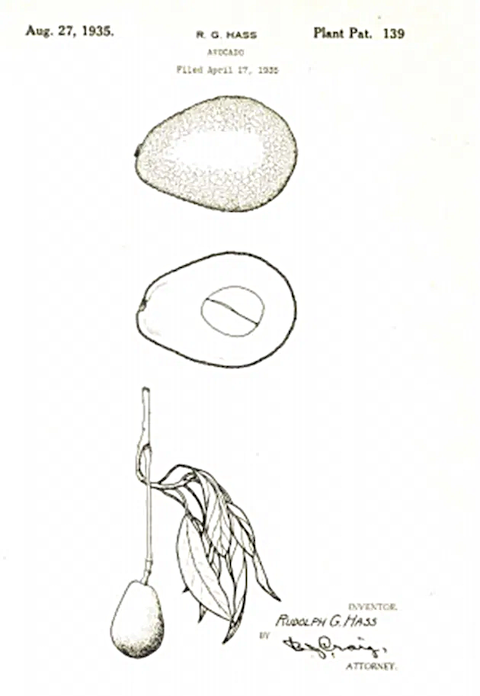
The 1935 Hass avocado patent was the first American patent awarded for a tree. Credit: Hass Avocado Mother Tree | The Mind Circle
- The undomesticated variety of avocado is a small black fruit with a large seed called a criollo that is thought to have coevolved with extinct megaherbivores like giant ground sloths, rhino-like toxodons, and elephant-like gomphotheres.
- In 2019, scientists sequenced the genome of the Hass avocado, finding that it is 61% Mexican and 39% Guatemalan, setting the stage for yet another intervention in the evolution of the avocado.
- Understanding the individual genes will enable scientists to improve disease and pest resistance, increase productivity and tinker with taste and texture of the fruit.
- Stand by for things like seedless avocados for your guacamole!
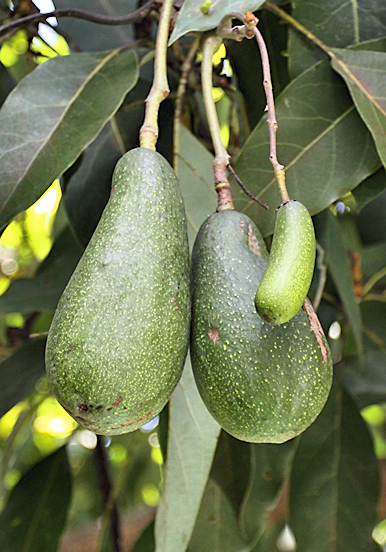
A seedless avocado growing next to two regular avocados. Location: San Pablo Huitzo, Oaxaca, Mexico. Credit: Nsaum75 at English Wikipedia, CC BY-SA 3.0 <https://creativecommons.org/licenses/by-sa/3.0>, via Wikimedia Commons

